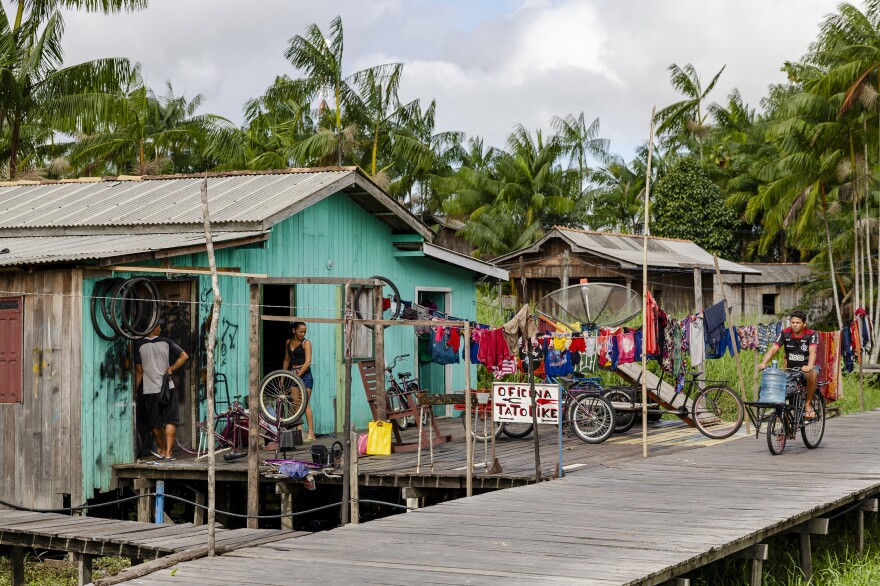AFUÁ, Brazil — Brazilian politicians stumping for reelection know the power of public largesse. So it was in 2010 when the incumbent governor of Pará state lavished city halls in this sprawling Amazonian province twice the size of France with tractors and motor graders to make roads.
In a remote tropical region, where tarmac is a totem of progress, no self-respecting mayor would snub such a bequest. No one except Odimar Wanderley Salomão, mayor of Afuá, who politely declined and had a good laugh — then astutely swapped his tractor chit for a riverboat.
Since 2002, this city on the Amazon River has been famously off-limits to motor vehicles. It wasn't a matter of environmental scruples. Cars and motorways had no place in this town of 38,000, much of which is built on stilts and sits above the chronically submersed floodplains of Marajó Island, near where the world's largest river empties into the Atlantic.
Locals call their hometown the Venice of the Amazon, because of its filigree of waterways and the fleet of boats that ply them. A visitor would be forgiven for thinking they'd landed in an outsize velodrome, such is the dizzying flow of cyclists zipping along the narrow streets. If Mayor Salomão — known to all as "Mazinho" — has his way, Afuá might yet be remembered as the city that pedaled its way to net-zero emissions.

He's got a good head start. Although there is no independent measure of municipal carbon emissions, this riverine community with one bicycle per capita and "the fittest legs in the Amazon," as Salomão boasts, stands out in a region still in thrall to fossil fuel-driven urban sprawl.
After all, this city of boardwalks, boats and bicycle-taxis is refreshingly free of the gridlock, tailpipe fumes and claxons that plague most fast-growing Amazon cities. The taboo on cars became law in 2022.
"Afuá is an example for the Amazon and Brazil, and maybe for the world," Mazinho told me in a recent interview. "We want people to come see for themselves," he added, in a nod to the scores of diplomats and heads of state set to gather next year in Belém, the storied Amazon port and host city for COP30, the headline United Nations climate summit.
The problem is getting there. Afuá sits on the upper lip of a fluvial island in Brazil's forgotten far north. There are no overland connections to the rest of the country. The local landing strip is often underwater. Travelers must either shell out for a flight to Macapá, a remote regional capital, then take a two to four-hour riverboat ride, or board a ship in Belém for a 27-hour cruise.

Generations of ambitious national leaders always took such isolation as an affront. They preached road building as a civilizational mission, no matter the devastation it wrought. Research in Brazil and Colombia shows that nearly all Amazon deforestation occurs within a few kilometers of roadways. Road by road, Amazon cities grew with their "backs to the river," as locals put it, often in reckless haste.
Traffic fatalities claimed 339,000 Brazilian lives from 2010 to 2019 and saw lethal road accidents jump 43% in the Amazon region, more than three times the national rate.
Rain and floods driven by increasingly rogue weather are an existential threat in southern Brazil, as the lethal deluges in Rio Grande do Sul state this month have made devastatingly clear. In Afuá, the seasonal high waters, known as lançantes, are the cue for a celebration. "When the floods come, we raise the furniture and fridge, put on flip flops and slosh into the streets to have fun until the waters recede," says Adiel de Souza Santos, 32, who sells açaí, a popular rainforest fruit.
Not everything in Afuá is a party. Fewer than 3 in 10 municipal residents live in homes with access to running water, sewage mains or garbage collection. Poverty and income inequality are among the worst in Brazil.

Like most Amazonian cities, the town depends on federal tax transfers just to pay its bills. For all the enthusiasm over the emerging green economy, city hall is the biggest employer. Afuá ranks 655th among 772 municipalities on the Amazon region's Social Progress Index, an aggregate of metrics for overall well-being.
Carbon neutrality, too, is a work in progress. One of the enduring paradoxes of the Amazon basin is that the same bounteous waterways that power the world's ninth economy and make Brazil a renewable energy standout often leave nearby towns in the dark. Afuá has yet to be plugged into the national grid fueled by hydroelectric dams. (A long overdue plan to do so is still in the works.) Hence, the constant growl and acrid whiff of diesel-burning thermoelectric plants and generators running night and day to keep the lights on.
What Afuá suggests is that pragmatic leadership and community consensus can make a difference even in one of the most chaotically urbanizing regions of the Americas. By turning off the combustion engine, resisting the tarmac temptation and abiding by centuries-old ways of the river, the town is a real time experiment in how to navigate an increasingly uncertain world where unruly climate change is overturning the rules of sustainable urban habitability. All this without a traffic light or tractor in sight.

Mac Margolis is a longtime reporter, columnist and scriptwriter covering Latin America, and author of The Last New World: the Conquest of the Amazon Frontier.
This story was produced with support from the Rainforest Journalism Fund in partnership with the Pulitzer Center.
Copyright 2024 NPR


